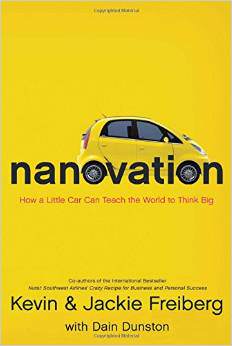How To Think Big and Act Bold
What sparks paradigm-shifting innovation in any business? It’s a special mix of entrepreneur and company, regular in every respect except for having the courage and foresight to make an idea happen that was supposed to be impossible. As an entrepreneur in a startup, how do you know if you have this potential, and what are the steps to get from an innovation to a revolution?
The first step is to meditate on the examples set by others, like Steve Jobs of Apple, Jeff Bezos of Amazon, or Thomas Edison with the electric light. There are many others, like the one I just finished about Ratan Tata bringing out the Nano car in 2009 in India for less than $2,500. The book is called “Nanovation,” by Kevin & Jackie Freiberg.
These authors have studied many such examples, and summarize my own perspective on the characteristics of entrepreneurs they call “nanovators,” that produce true, life-changing innovations, which they call nanovations:
- Get wired for nanovation. We all agree that innovation is an adventure into the unknown. If you want people to follow, you need to be able to convince them of three things: (1) your mission is worth supporting, (2) you have the competence to build a critical mass, and (3) you have integrity to look out for their best interests along the way.
- Lead the revolution. Nanovators have more than the vision; they have the drive to lead, and the focus to stay on target. They are wired to win. Organizations don’t produce game-changing innovations; people do. They allow a leap of faith in their own ideas, as well as in the ideas and capabilities of their team.
- Build a culture of innovation. You need a culture where restlessness is tolerated, curiosity is encouraged, passion is inspired, creativity is expected, and people are always talking about what’s next. Ultimately, the mind-set changes so significantly that innovation is natural, and no one is conscious of it.
- Question the unquestionable. Outsiders ask a lot of questions because they don’t presume to know why something is done a certain way. Make your insiders think like outsiders. Provocative questions like “What if?”, “Why not?”, or “So what?” can help to get everyone outside the box.
- Look beyond customer imagination. First-of-a-kind products empower customers to do things they didn’t even know they wanted to do, and now can’t live without them. The computer mouse, Tivo, and Teflon are examples. Listen to customers, but remember that they can’t always tell you what they don’t know.
- Go to the intersection of trends. Nanovators pay close attention to the early warning signs that precede major cultural, societal, and market shifts. Where most people see an isolated trend, nanovators connect the dots by relating one trend to several others. They focus on next practices, versus best practices.
- Solve a problem that matters. The key here is to resist the temptation to pay more attention to the technology solution than the problem. Some people create brilliant solutions to non-existent problems, like maybe Segway and satellite phones. These solutions may be nice to have, but won’t ignite a revolution to get there.
- Risk more, fail faster, and bounce back stronger. When you pursue a creative idea that takes you beyond, fear tempts you to make compromises. If you can push through this fear and doubt, or bounce back intelligently from initial setbacks, you often arrive at something that has truly never been seen before.
Jeffrey Immelt of General Electric argues that the next big thing, like the Nano, could well be from “reverse innovation,” where instead of industrialized nations adapting their products for emerging markets, innovation in emerging markets will bring new paradigms to home markets. In any case, the future is defined by what we put off until tomorrow, so don’t wait too long to get started.

